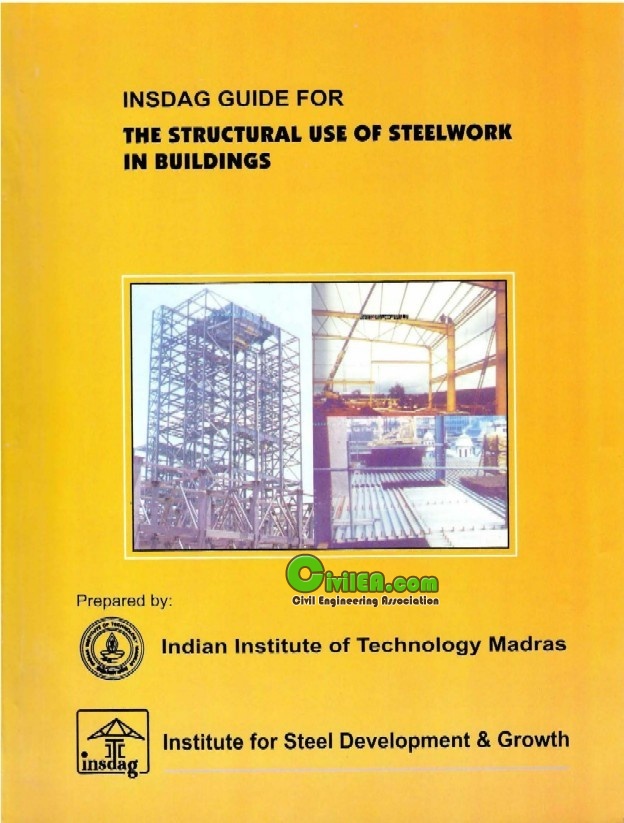THE STRUCTURAL USE OF STEELWORK IN BUILDINGS
http://forum.civilea.com/showthread.php?tid=19905
Author: Rangachari Narayanan, V. Kalyanaraman | Size: 10.28 MB | Format: PDF |
Publisher: Institute for Steel Development And Gro | Year: 2003 | pages: 198 | ISBN: none
بند انگشتی, برای دیدن عکس به صورت کامل بر روی آن کلیک نمایید
FOREWARD
INSDAG has played a pivotal role over the last few years in propagating the awareness amongst students, faculties of various engineering institutes and experts and professionals from various industries, about the advantages and benefits of usage of steel in the construction sector. It is now being accepted by most engineering professionals both academic and industrial, that the main stumbling block in the development of the steel construction industry in India is the primitiveness of the methods of design adopted by the Indian codes as against the international codes which allow higher flexibility in design approach. The relevant Indian codes of practice (IS: 800-1984 and IS: 801-1975) applicable for hot-rolled and cold-formed steel are based on the "Allowable Stress Design" approach as against the more internationally popular "Limit State Method" approach which has been proved to be technically sound and its use results in optimum economy of the structure.
With the technical contributions from leading academics and professionals, INSDAG has already brought out various publications on the design methodology of steel structures using the Limit State Method of Design (LSM), which have been beneficial to the engineering fraternity in learning the most intricate facets in LSM design. On request from INSDAG, this publication in the form of a Guide book has been written and compiled by Dr. Rangachari Narayanan and Dr. V. Kalyanraman for the benefit of not only the student community both under-graduate and post graduate level, but also other engineering professionals across the country, since most of the engineering institutions have started including the LSM design in their curriculum and also the engineering professionals need to update themselves with the latest technological advancements. The publication is very timely as it coincides with the revision of IS: 800- 1984, which is at its advanced stage.
The entire book has been reviewed by^Dr. T. K. Bandyopadhyay, Deputy Director General and Mr. Arijit Guha, Manager (Civil & Structural). Comments and suggestions received from a large number of faculty member*, have been incorporated. INSDAG expresses its indebtedness to Dr. R. Narayanan and Dr. V. Kalyanraman, academics and researchers of international experience for agreeing to bring'out this publication.
Kolkata: February 2003
Special Note
The entire document has been written considering Limit State Method of design following stipulations laid down in the relevant British code, BS: 5950 Part -1, 3 & 5 and Eurocode - 3 & 4. Since IS: 800 (Code of Practice for General Construction in Steel) is presently being revised to Limit State version, this guide book may undergo certain modifications in some chapters after the publication of revised IS: 800 (LSM version) to accommodate the possible variation in stipulations that are likely to be considered in the revised code.
However, this document will be extremely useful to the students of Civil I Structural Engineering to understand the theoretical background associated with advancement in structural steel design based on Limit State Method.
http://www.steel-insdag.org/new/E-Book/INS_50.pdf
دوست عزیز، به سایت علمی نخبگان جوان خوش آمدید
مشاهده این پیام به این معنی است که شما در سایت عضو نیستید، لطفا در صورت تمایل جهت عضویت در سایت علمی نخبگان جوان اینجا کلیک کنید.
توجه داشته باشید، در صورتی که عضو سایت نباشید نمی توانید از تمامی امکانات و خدمات سایت استفاده کنید.







 پاسخ با نقل قول
پاسخ با نقل قول


علاقه مندی ها (Bookmarks)